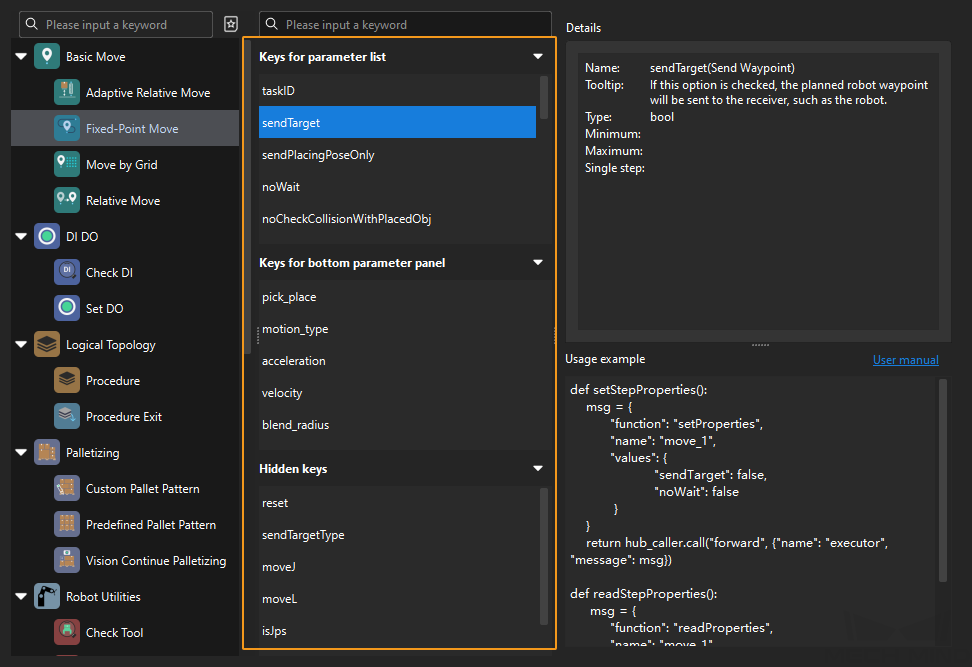UR e-Series (PolyScope X 10.4 or Above) Standard Interface Commands
This section describes standard interface commands used in TCP communications between a UR e-Series (PolyScope X 10.4 or Above) robot and Mech-Mind Vision System. The robot (the client) sends commands to Mech-Mind Vision System (the server), and Mech-Mind Vision System returns the processed data to the robot.
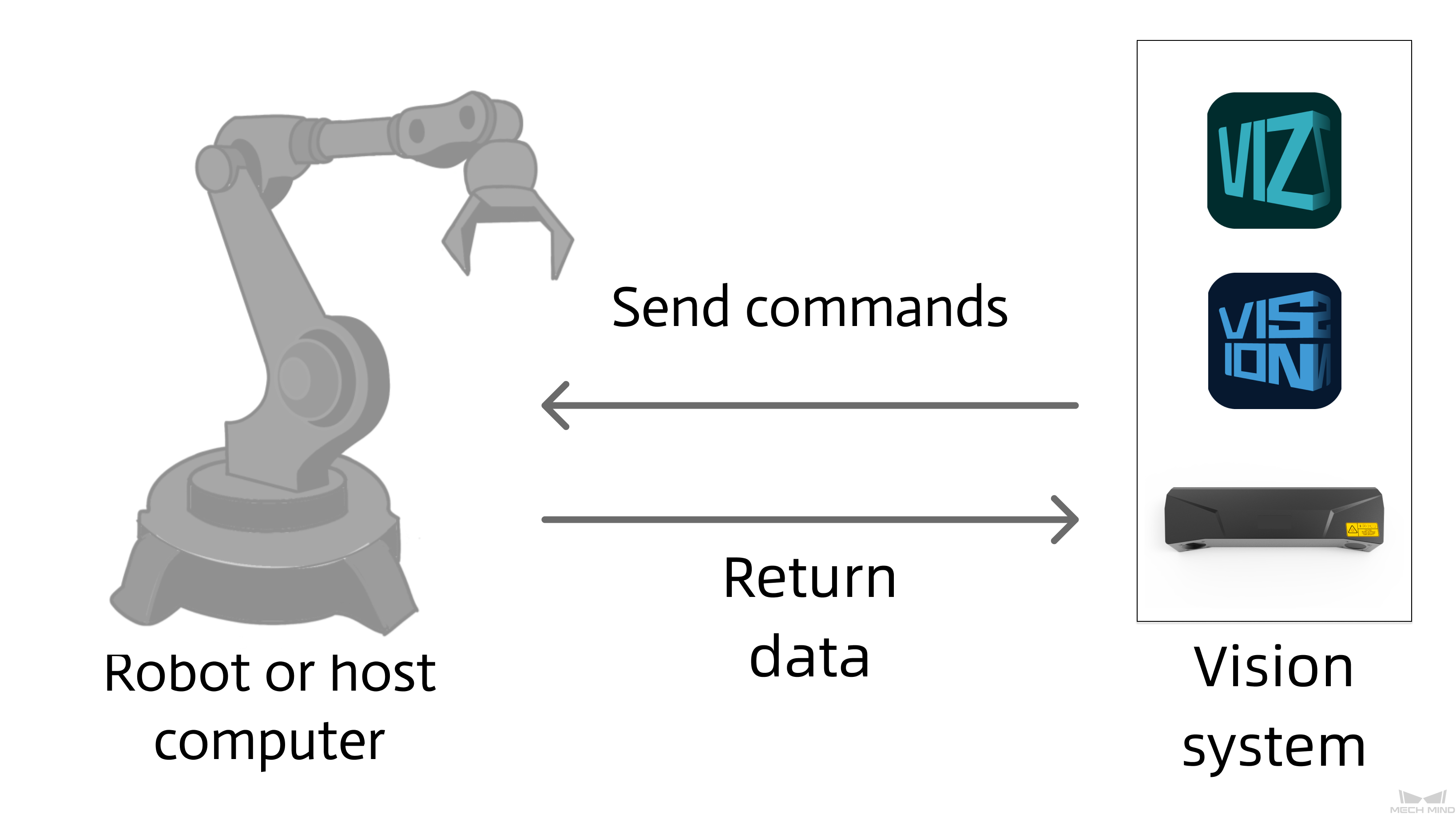
Command Overview
Commands related to Mech-Vision |
Commands related to Mech-Viz |
Precautions
-
Unit of data:
-
The unit of joint positions is degree (°).
-
A robot’s flange pose or TCP consists of the position and pose. The position is represented in XYZ coordinates and is measured in millimeters (mm); the pose is represented in Euler angles and is measured in degrees (°).
-
-
Vision point and waypoint:
-
Vision point: An object recognized by Mech-Vision. A vision point has information including the object pose, label, dimensions, and custom data.
-
Waypoint: Each point that the robot reaches when moving along the planned path. A waypoint has information including the robot pose, label, and motion type. Waypoints can be divided into two categories:
-
Vision Move waypoint: Waypoint corresponding to the Vision Move Step.
-
Non-Vision Move waypoints, which refer to the waypoints corresponding to Move-type Steps other than the Vision Move Step.
-
-
Initialize Communication
Description
This command sets the IP address of the IPC, port number, and timeout period for robot communication.
Calling Sequence
To establish the communication between the robot and the vision system, call Establish TCP Communication after this command.
Command
MMInitSocketParameters
ipAddress
This parameter specifies the IP address of the IPC.
port
This parameter specifies the port number used by the IPC to establish the communication between the IPC and the robot. This port number must be consistent with the host port number that is specified for robot communication in the toolbar of Mech-Vision.
TimeOut
This parameter specifies the communication timeout period. Unit: seconds.
Run Mech-Vision Project
Description
This command triggers the Mech-Vision project to run. When the Mech-Vision project is running, the vision system triggers the camera to capture images and then process the returned images with algorithms to produce a series of vision points or waypoints.
|
Calling Sequence
-
You should set Step parameters before starting a Mech-Vision project. Therefore, call Switch Mech-Vision Parameter Recipe or Input Object Dimensions to Mech-Vision Project before calling Run Mech-Vision Project.
-
Vision system gets vision points and waypoints only after a Mech-Vision project runs. Therefore, call Run Mech-Vision Project before calling Get Mech-Vision Data.
Command
MMStartVisInput Parameters
ProjectId
Mech-Vision project ID. You can view the project ID of a Mech-Vision project in the Project List section of Mech-Vision. The project ID is the number before the project name.
PosNumberNeed
This parameter specifies the number of vision points or waypoints expected to be returned by the Mech-Vision project. Valid values: 0 to the largest positive integer.
| If the Mech-Vision project has a Path Planning Step, this parameter indicates the expected number of waypoints. Otherwise, it indicates the expected number of vision points. |
-
0: Obtain all vision points or waypoints from the Mech-Vision project.
-
A positive integer: Obtain the specific number of vision points or waypoints from the Mech-Vision project.
-
If the total amount of vision points or waypoints output by the Mech-Vision project is smaller than the parameter value, this command will obtain the number of all vision points or waypoints.
-
If the total amount of vision points or waypoints output by the Mech-Vision project is larger than or equal to the parameter value, this command will obtain the number of vision points or waypoints as specified by this parameter.
-
|
Type of robot pose to send
This parameter specifies the pose type of the real robot to send to the Mech-Vision project. Valid values: None, Current position, and Predefined Jps. The following table describes the details.
| Type of robot pose to send | Description | Application scenario |
|---|---|---|
None |
The command does not send the robot pose to the Mech-Vision project. If the Path Planning Step is used in the Mech-Vision project, the start point of the planned path will be the Home point set in the path planning tool. |
This setting should be used if the camera is mounted in eye to hand mode and the project does not require images to be captured beforehand. |
Current position |
The robot joint positions and flange pose must be input to the Mech-Vision project. The joint positions and flange pose are set in the Current position variable. |
This setting should be used when the camera is mounted in eye in hand mode. This setting is recommended for most scenarios except those involving gantry robots. |
Predefined Jps |
This command sends custom joint positions to the Mech-Vision project. These joint positions will be sent to the Path Planning Step in the Mech-Vision project as the start point, where the robot will move from this start point to the first waypoint of the planned path.
|
This setting should be used if the camera is mounted in eye to hand mode and the project requires images to be captured beforehand. |
Get Mech-Vision Data
Calling Sequence
This command should be called after Run Mech-Vision Project.
Command
MMGetVisDataParameters
Result Type: Basic (get vision result)
Input Parameters
ProjectId
Mech-Vision project ID. You can view the project ID of a Mech-Vision project in the Project List section of Mech-Vision. The project ID is the number before the project name.
Result Type
Set Result Type to Basic to indicate that the vision result exported by Mech-Vision is obtained as a series of vision points.
Starting at ID
This parameter specifies the starting index for vision points. Starting from the specified index, the poses and labels of all subsequent vision points will be saved sequentially to specific variables. For example, if the parameter is set to 1, the data corresponding to each vision point will be saved starting from the first vision point.
Output Parameters
Pose
This parameter stores the poses of all vision points. The object pose of the vision point (namely, the output of the poses port of the Output Step) will be automatically converted to the robot’s TCP by the vision system. The process is as follows.
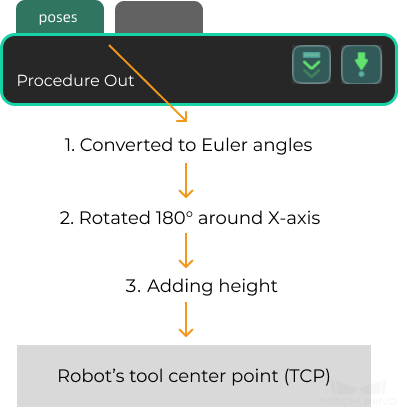
-
Convert the object pose from a quaternion to Euler angles.
-
Rotate the object’s pose around the X-axis by 180° to orient its Z-axis downward.
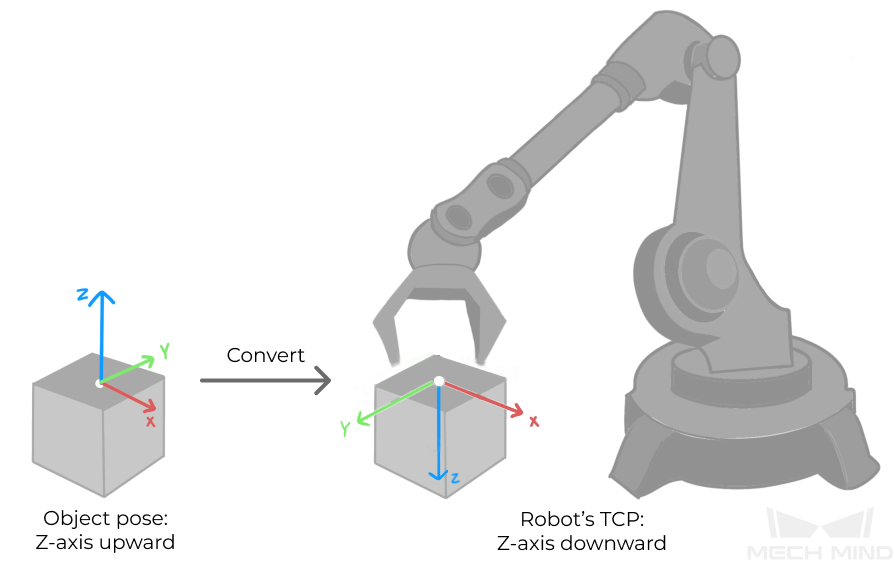
Label
This parameter stores the labels of all vision points.
Last Data
This parameter specifies whether all vision points are obtained. The value is 0 or 1.
-
0: Not all vision points are obtained.
-
1: All vision points are obtained.
Total Received
This parameter indicates the number of obtained vision points. By default, the vision system sends no more than 15 vision points at a time. Therefore, the maximum default value of this parameter is 15.
Status_Code
This parameter indicates the name of the variable for storing the command execution status code. Status code 1100 is returned for a successful command execution. If a command fails to be run, a specific error code is returned. For details, see Status Codes and Troubleshooting.
Result Type: Custom (get custom data from Mech-Vision)
Input Parameters
ProjectId
Mech-Vision project ID. You can view the project ID of a Mech-Vision project in the Project List section of Mech-Vision. The project ID is the number before the project name.
Result Type
Set Result Type to Custom to indicate that, in addition to obtaining data from the poses and labels ports of the Output Step in the Mech-Vision project, data is also obtained from the custom ports of the Step.
Select the Output Step, set Port Type to Custom, and then click Open the editor to go to the custom port configuration window. The Customized Keys section of the window displays custom port names, such as customeData1 and customeData2 as shown in the following figure.
|
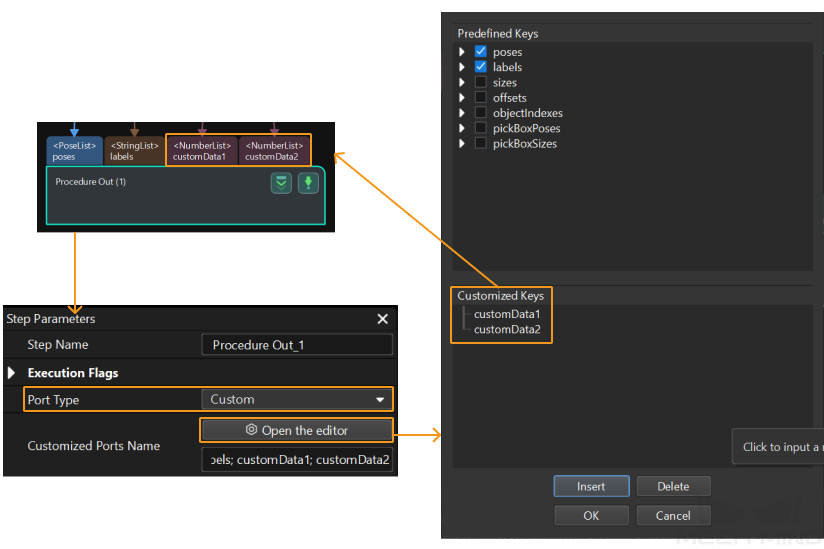
Starting at ID
This parameter specifies the starting index for vision points. Starting from the specified index, the poses, labels, and custom data of all subsequent vision points will be saved sequentially to specific variables. For example, if the parameter is set to 1, the data corresponding to each vision point will be saved starting from the first vision point.
Output Parameters
Pose
This parameter stores the poses of all vision points. The object pose of the vision point (namely, the output of the poses port of the Output Step) will be automatically converted to the robot’s TCP by the vision system. The process is as follows.

-
Convert the object pose from a quaternion to Euler angles.
-
Rotate the object’s pose around the X-axis by 180° to orient its Z-axis downward.

Label
This parameter stores the labels of all vision points.
Last Data
This parameter specifies whether all vision points are obtained. The value is 0 or 1.
-
0: Not all vision points are obtained.
-
1: All vision points are obtained.
Total Received
This parameter indicates the number of obtained vision points. By default, the vision system sends no more than 15 vision points at a time. Therefore, the maximum default value of this parameter is 15.
Status_Code
This parameter indicates the name of the variable for storing the command execution status code. Status code 1100 is returned for a successful command execution. If a command fails to be run, a specific error code is returned. For details, see Status Codes and Troubleshooting.
Custom Data
This parameter stores the custom data of all vision points. This parameter value is a two-dimensional matrix, where Custom Data[0,0] represents the total number of custom elements, Custom Data[1,0] indicates the number of custom elements for the first vision point, Custom Data[1,1] represents the first custom element of the first vision point, Custom Data[1,2] represents the second custom element of the first vision point, and so on.
Result Type: Planned path (get planned path from Mech-Vision)
Input Parameters
ProjectId
Mech-Vision project ID. You can view the project ID of a Mech-Vision project in the Project List section of Mech-Vision. The project ID is the number before the project name.
Result Type
Set Result Type to Planned path to indicate that the planned path is obtained from Mech-Vision as a series of waypoints. The path is planned by the path planning tool, which you may enter by clicking Config wizard as shown in the image below. For details about Path Planning, see Path Planning.
| Set the Port Type parameter of the Output Step in Mech-Vision to Predefined (robot path). |
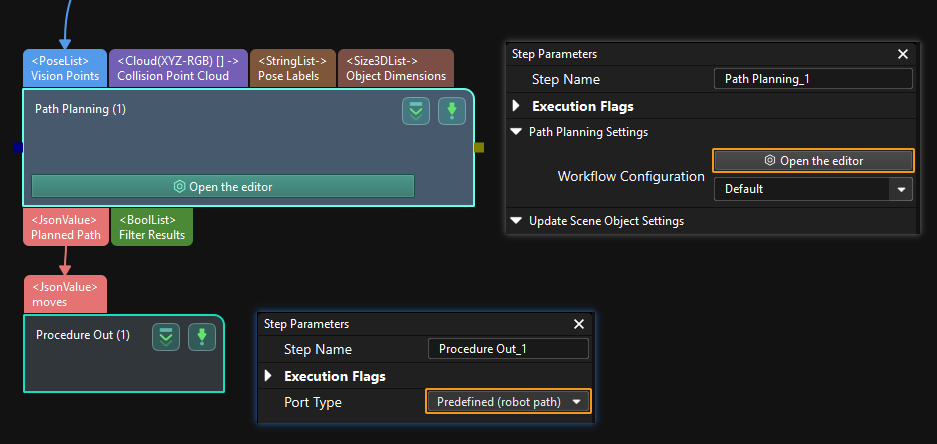
Starting at ID
This parameter specifies the starting index for waypoints. Starting from the specified index, the poses, labels, and tool IDs of all subsequent waypoints will be saved sequentially to specific variables. For example, if the parameter is set to 1, the data corresponding to each waypoint will be saved starting from the first waypoint.
Return Type
This parameter specifies the type of waypoint poses to be obtained. Valid values: Jps and Tcp.
-
Jps: joint positions.
-
Tcp: TCP.
Output Parameters
Pose
This parameter stores the poses of all waypoints.
|
Label
This parameter stores the labels of all waypoints.
Last Data
This parameter specifies whether all waypoints are obtained. The value is 0 or 1.
-
0: Not all waypoints are obtained.
-
1: All waypoints are obtained.
Total Received
This parameter indicates the number of obtained waypoints. By default, the vision system sends no more than 15 waypoints at a time. Therefore, the maximum default value of this parameter is 15.
Status_Code
This parameter indicates the name of the variable for storing the command execution status code. Status code 1103 is returned for a successful command execution. If a command fails to be run, a specific error code is returned. For details, see Status Codes and Troubleshooting.
Tool Id
This parameter stores the tool IDs of all waypoints.
Picking Point Index
This parameter indicates the sequence number of the Vision Move waypoint corresponding to the “Vision Move” Step of the path planning tool in the entire path. If the path does not contain a “Vision Move” waypoint, the value of this parameter is 0.
For example, if the planned path consists of the following waypoints: "Fixed-Point Move_1", "Fixed-Point Move_2", "Vision Move", "Fixed-Point Move_3", the position number of the Vision Move waypoint is 3.
Get Joint Positions
Switch Mech-Vision Parameter Recipe
Description
This command triggers Mech-Vision to switch the parameter recipe used by the project. The image below shows how to manually switch the parameter recipe for a Mech-Vision project. For details about parameter recipes, see the parameter recipe guide.
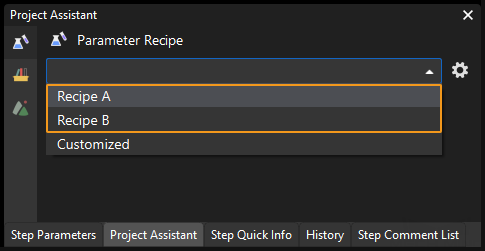
Calling Sequence
This command should be called before Run Mech-Vision Project.
Command
MMSwitchModelInput Parameters
ProjectId
Mech-Vision project ID. You can view the project ID of a Mech-Vision project in the Project List section of Mech-Vision. The project ID is the number before the project name.
RecipeId
This parameter indicates the parameter recipe ID in the Mech-Vision project. For details on how to check the parameter recipe ID, see View the Parameter Recipe ID.
Input Object Dimensions to Mech-Vision Project
Description
This command dynamically inputs object dimensions into the Mech-Vision project. The object dimensions are the values of the Box Size Settings parameters in the Read Object Dimensions Step, as shown in the following figure.
| When you use this command, only one Read Object Dimensions Step is allowed in the Mech-Vision project. Otherwise, the vision system will return an error. |

Calling Sequence
This command should be called before Run Mech-Vision Project.
Command
MMSetBoxSizeInput Parameters
ProjectId
Mech-Vision project ID. You can view the project ID of a Mech-Vision project in the Project List section of Mech-Vision. The project ID is the number before the project name.
Length, Width, Height
The preceding three parameters sequentially input the length, width, and height of the object to the Mech-Vision project. The length, width, and height are measured in millimeters (mm). These values are read by the Read Object Dimensions Step and set for the parameters Length on X-axis, Length on Y-axis and Length on Z-axis.
Run Mech-Viz Project
Description
This command triggers the Mech-Viz project to run. Mech-Viz plans the robot’s motion path based on the vision result output by Mech-Vision.
| Right-click the project name in the project resource panel in Mech-Viz and select Autoload Project. |
Calling Sequence
You should set Step parameters before starting a Mech-Viz project. Therefore, call Read Mech-Viz Step Parameter or Set Mech-Viz Step Parameter before calling Run Mech-Viz Project.
Command
MMStartVizInput Parameters
Type of robot pose to send
This parameter specifies the way in which the pose of the real robot is sent to the Mech-Viz project. Valid values: None, Current position, and Predefined Jps. The following table describes the details.
| Type of robot pose to send | Description | Application scenario |
|---|---|---|
None |
This command does not need to send the robot pose to Mech-Viz. The simulated robot in the Mech-Viz project will move from the set home position to the first waypoint. |
This setting is recommended when the camera is mounted in eye to hand mode. |
Current position |
In this command, the robot sends its current joint positions and flange pose to the Mech-Viz project. The simulated robot in Mech-Viz moves from the input joint positions to the first waypoint. The joint positions and flange pose are set in the Current position variable. |
This setting is recommended when the camera is mounted in eye in hand mode. |
Predefined Jps |
In this command, the robot sends the joint positions of a teach point (the custom joint positions, instead of the current joint positions, which is set by using Predefined Jps) to the Mech-Viz project. The Mech-Viz project uses the input joint positions to plan the next path in advance while the robot is not in the camera capture region. The simulated robot in Mech-Viz moves from the input joint positions to the first waypoint. |
This setting is recommended when the camera is mounted in eye to hand mode. |
Stop Mech-Viz Project
Calling Sequence
This command should be called after Run Mech-Viz Project.
Set the Exit Port for the Branch by Msg Step in Mech-Viz
Description
This command sets the exit port for the Branch by Msg Step. When the next Step is a Branch by Msg Step, the Mech-Viz project will wait for this command to specify the exit port.
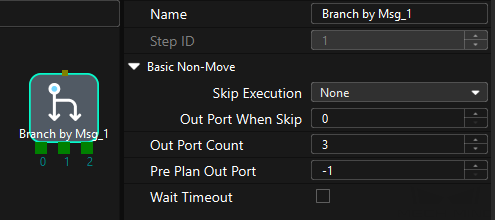
Calling Sequence
This command should be called after Run Mech-Viz Project.
Command
MMSetBranchInput Parameters
BranchNum
This parameter specifies the “Branch by Msg” Step by its ID. Valid values: positive integers. The Step ID is displayed in the Step parameter panel. For example, the Step ID of the Step in the image above is 1.
PortNum
This parameter indicates the exit port of the Branch by Msg Step. Valid values: positive integers. When the parameter value is set to N, the Mech-Viz project exits from the port with an ID of N-1 of the Branch by Msg Step.
Set Current Index in Mech-Viz
Description
This command sets the value of the Current Index parameter of index-type Steps. Index-type Steps are Steps that include the Index section, which include Move by Grid, Move by List, Custom Pallet Pattern, and Predefined Pallet Pattern.

Calling Sequence
Index-type Steps are often preceded by a Branch by Msg Step. The robot should call commands in this order: Run Mech-Viz Project, Set Current Index in Mech-Viz, and Set the Exit Port for the Branch by Msg Step in Mech-Viz. This is to ensure that Mech-Viz has enough time to set the Current Index value.
Command
MMSetIndexInput Parameters
SkillNum
This parameter specifies the Step ID of the Index-type Step. Valid values: positive integers. The Step ID is displayed in the Step parameter panel. For example, the Step ID of the Step in the image above is 3.
IndexNum
This parameter sets the value of the Current Index parameter of index-type Steps. Valid values: positive integers. When this parameter value is set to N, the current index of the corresponding Step is N-1.
Get Mech-Viz Data
Description
This command obtains the path planned by the Mech-Viz project as a series of waypoints.
|
Waypoint: Each point that the robot reaches when moving along the planned path. A waypoint has information including the robot pose, label, and motion type. Waypoints can be divided into two categories:
|
Calling Sequence
This command should be called after Run Mech-Viz Project.
Command
MMGetVizDataParameters
Result Type: Basic Path (get planned path from Mech-Viz)
Input Parameters
Result Type
Set Result Type to Basic path to indicate that the motion path is obtained from the Mech-Viz project as a series of waypoints.
|
Waypoint: Each point that the robot reaches when moving along the planned path. A waypoint has information including the robot pose, label, and motion type. Waypoints can be divided into two categories:
|
Starting at ID
This parameter specifies the starting index for waypoints. Starting from the specified index, the poses, labels, and tool IDs of all subsequent waypoints will be saved sequentially to specific variables. For example, if the parameter is set to 1, the data corresponding to each waypoint will be saved starting from the first waypoint.
Return Type
This parameter specifies the type of waypoint poses to be obtained. Valid values: Jps and Tcp.
-
Jps: joint positions.
-
Tcp: TCP.
Output Parameters
Pose
This parameter stores the poses of all waypoints.
|
Label
This parameter stores the labels of all waypoints.
Last Data
This parameter specifies whether all waypoints are obtained. The value is 0 or 1.
-
0: Not all waypoints are obtained.
-
1: All waypoints are obtained.
Total Received
This parameter indicates the number of obtained waypoints. By default, the vision system sends no more than 15 waypoints at a time. Therefore, the maximum default value of this parameter is 15.
Status Code
This parameter indicates the name of the variable for storing the command execution status code. Status code 2100 is returned for a successful command execution. If a command fails to be run, a specific error code is returned. For details, see Status Codes and Troubleshooting.
Tool Id
This parameter stores the tool IDs of all waypoints.
Picking Point Index
This parameter specifies the sequence number of the Vision Move waypoint (i.e., the waypoint corresponding to the “Vision Move” Step in the Mech-Viz project) in the planned path. If the path does not contain a “Vision Move” waypoint, the value of this parameter is 0.
For example, if the planned path consists of the following waypoints: "Fixed-Point Move_1", "Fixed-Point Move_2", "Vision Move", "Fixed-Point Move_3", the position number of the Vision Move waypoint is 3.
Result Type: Planning Data (get planned path, Vision Move planned path or custom data from Mech-Viz)
Input Parameters
Result Type
Set Result Type to Planned Data to indicate that, in addition to obtaining the planned path from the Mech-Viz project, Vision Move data or custom data is also obtained.
-
Vision Move data refers to data output by the Vision Move Step in Mech-Viz, including the labels of picked workobjects, number of picked workobjects, number of workobjects to be picked this time, edge or corner ID of vacuum gripper, TCP offset, orientation of workobject group, orientation of workobject, and dimensions of workobject group.
-
Custom data refers to data output by the custom port(s) of the Output Step in Mech-Vision and then forwarded by Mech-Viz.
Select the Output Step, set Port Type to Custom, and then click Open the editor to go to the custom port configuration window. The Customized Keys section of the window displays custom port names, such as customeData1 and customeData2 as shown in the following figure.
-
Data output from Predefined Keys, such as poses, labels, sizes, offsets, is not custom data.
-
You must set Port Type of the Output Step to Custom and select the poses port in the Predefined Keys section in Mech-Vision.

-
Starting at ID
This parameter specifies the starting index for waypoints. Starting from the specified index, the poses, tool IDs, and Vision Move or custom data of all subsequent waypoints will be saved sequentially to specific variables. For example, if the parameter is set to 1, the data corresponding to each waypoint will be saved starting from the first waypoint.
Return Type
This parameter specifies the type of waypoint poses to be obtained. Valid values: Jps and Tcp.
-
Jps: joint positions.
-
Tcp: TCP.
Output Parameters
Pose
This parameter stores the poses of all waypoints.
|
Last Data
This parameter specifies whether all waypoints are obtained. The value is 0 or 1.
-
0: Not all waypoints are obtained.
-
1: All waypoints are obtained.
Visual Move Or Not
This parameter indicates the type of the waypoint. Valid values: 0 and 1.
Visual Move Or Not |
Waypoint type |
Data |
0 |
Non-Vision Move waypoint |
Pose and tool ID |
1 |
Vision Move waypoint |
pose, tool ID, Vision Move data, custom output data (which will not be returned if the Mech-Vision project does not have a custom port) |
Picking Point Index
This parameter specifies the sequence number of the Vision Move waypoint (i.e., the waypoint corresponding to the “Vision Move” Step in the Mech-Viz project) in the planned path. If the path does not contain a “Vision Move” waypoint, the value of this parameter is 0.
For example, if the planned path consists of the following waypoints: "Fixed-Point Move_1", "Fixed-Point Move_2", "Vision Move", "Fixed-Point Move_3", the position number of the Vision Move waypoint is 3.
Total Received
This parameter indicates the number of obtained waypoints. By default, the vision system sends no more than 15 waypoints at a time. Therefore, the maximum default value of this parameter is 15.
Status Code
This parameter indicates the name of the variable for storing the command execution status code. Status code 2100 is returned for a successful command execution. If a command fails to be run, a specific error code is returned. For details, see Status Codes and Troubleshooting.
Tool Id
This parameter stores the tool IDs of all waypoints.
Plan Data
This parameter stores the obtained Vision Move planned data. Among them, the variables Plan Data[0,0] to Plan Data[0,21] and Plan Data[N,0] are meaningless. The Vision Move data for the first waypoint will be stored in Plan Data[1,1] to Plan Data[1,21], and so on.
| If the waypoint is a non-Vision Move waypoint, Plan Data[N,1] to Plan Data[N,21] will be 0 and have no actual meaning. |
If the first waypoint is a Vision Move waypoint, the Vision Move data corresponding to the waypoint is described in the table below.
| Data | Description | Variable |
|---|---|---|
Labels of picked workobjects |
A label consists of 10 integers. The default value is ten 0s. |
Plan Data[1,1]~Plan Data[1,10] |
Number of picked workobjects |
The total number of picked workobjects. |
Plan Data[1,11] |
Number of workobjects to be picked this time |
Number of workobjects to be picked this time |
Plan Data[1,12] |
Edge or corner ID of vacuum gripper |
The ID of the edge or corner used to pick workobjects this time. |
Plan Data[1,13] |
TCP offset |
The XYZ offset between the center of the workobject group and the tool pose center. |
Plan Data[1,14]~Plan Data[1,16] |
Orientation of workobject group |
The relative position between the workobject group and the length of the vacuum gripper. The value is 0 or 1, where 0 stands for parallel and 1 for vertical. |
Plan Data[1,17] |
Orientation of workobject |
The relative position between the length of a workobject and that of the vacuum gripper. The value is 0 or 1, where 0 stands for parallel and 1 for vertical. |
Plan Data[1,18] |
Dimensions of workobject group |
The length, width, and height of the workobject group to be picked this time. |
Plan Data[1,19]~Plan Data[1,21] |
Custom Data
This parameter stores the custom data of all waypoints. This parameter value is a two-dimensional matrix, where Custom Data[0,0] represents the total number of custom elements, Custom Data[1,0] indicates the number of custom elements for the first waypoint, Custom Data[1,1] represents the first custom element of the first waypoint, Custom Data[1,2] represents the second custom element of the first waypoint, and so on.
Result Type: Custom (get planned path and custom data from Mech-Viz)
Input Parameters
Result Type
Set Result Type to Custom Data to indicate that, in addition to obtaining the planned path from the Mech-Viz project, custom data is also obtained. Custom data refers to data output by the custom port(s) of the Output Step in Mech-Vision and then forwarded by Mech-Viz.
Select the Output Step, set Port Type to Custom, and then click Open the editor to go to the custom port configuration window. The Customized Keys section of the window displays custom port names, such as customeData1 and customeData2 as shown in the following figure.
|

Starting at ID
This parameter specifies the starting index for waypoints. Starting from the specified index, the poses, tool IDs, and custom data of all subsequent waypoints will be saved sequentially to specific variables. For example, if the parameter is set to 1, the data corresponding to each waypoint will be saved starting from the first waypoint.
Return Type
This parameter specifies the type of waypoint poses to be obtained. Valid values: Jps and Tcp.
-
Jps: joint positions.
-
Tcp: TCP.
Output Parameters
Pose
This parameter stores the poses of all waypoints.
|
Last Data
This parameter specifies whether all waypoints are obtained. The value is 0 or 1.
-
0: Not all waypoints are obtained.
-
1: All waypoints are obtained.
Visual Move Or Not
This parameter indicates the type of the waypoint. Valid values: 0 and 1.
Visual Move Or Not |
Waypoint type |
Data |
0 |
Non-Vision Move waypoint |
Pose and tool ID |
1 |
Vision Move waypoint |
Poses, tool IDs, and custom data (custom ports must exist in the Mech-Vision project) |
Total Received
This parameter indicates the number of obtained waypoints. By default, the vision system sends no more than 15 waypoints at a time. Therefore, the maximum default value of this parameter is 15.
Status Code
This parameter indicates the name of the variable for storing the command execution status code. Status code 2100 is returned for a successful command execution. If a command fails to be run, a specific error code is returned. For details, see Status Codes and Troubleshooting.
Tool Id
This parameter stores the tool IDs of all waypoints.
Custom Data
This parameter stores the custom data of all waypoints. This parameter value is a two-dimensional matrix, where Custom Data[0,0] represents the total number of custom elements, Custom Data[1,0] indicates the number of custom elements for the first waypoint, Custom Data[1,1] represents the first custom element of the first waypoint, Custom Data[1,2] represents the second custom element of the first waypoint, and so on.
Read Mech-Viz Step Parameter
Calling Sequence
This command should be called before Run Mech-Viz Project.
Command
MMReadPropertyInput Parameters
ID
This parameter corresponds to the Config ID field defined in the property_config file.
|
From the toolbar of Mech-Vision, go to . Click Property Configuration to open the property_config file. 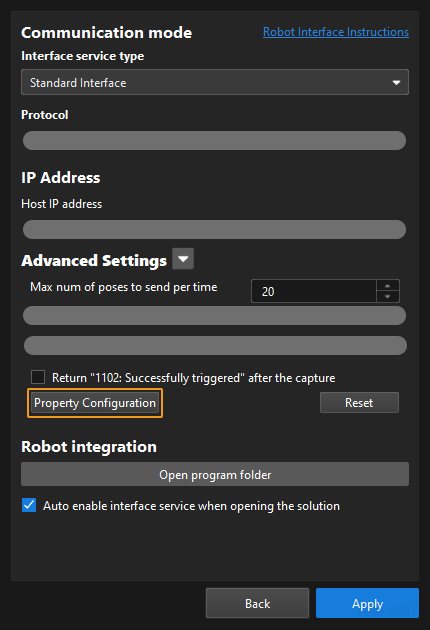
|
Before calling this function, you should define a Config ID and its corresponding Step ID and parameter key name in the following format in the property_config file.
read, Config ID, Step ID, parameter key name
read |
Indicates that this line is used to read the parameter value of a Step. |
Config ID |
Specifies a unique ID, which is a positive integer. One Config ID corresponds to only one parameter value of a Step. To read multiple parameter values, you should set different Config IDs. |
Step ID |
The Step ID of the Step whose parameter is to be read. |
parameter key name |
Specifies the key name of the parameter whose value the robot requires to read. |
|
|
The property_config file can have multiple read commands. The Config ID in these commands must be different. |
Set Mech-Viz Step Parameter
Calling Sequence
This command should be called before Run Mech-Viz Project.
Command
MMSetPropertyInput Parameters
ID
This parameter corresponds to the Config ID field defined in the property_config file.
|
From the toolbar of Mech-Vision, go to . Click Property Configuration to open the property_config file. 
|
Before sending this command, you should define a Config ID and its corresponding Step ID, parameter key name and parameter value in the following format in the property_config file.
write, Config ID, Step ID, parameter key name, parameter value
write |
Indicates that this line is used to set the parameter value of a Step. |
Config ID |
Specifies an ID, which is a positive integer and can be used repeatedly. |
Step ID |
Specifies the Step whose parameter value the robot requires to read. |
parameter key name |
Specifies the key name of the parameter whose value the robot requires to set. |
parameter value |
Specifies the value that the robot sets for the parameter. |
|
Get Gripper DO List
Description
This command obtains the control signal list for the multi-section vacuum gripper from the Mech-Vision or Mech-Viz project.
Before using this command, you must perform the following configurations in Mech-Vision or Mech-Viz.
-
Configure the Mech-Vision project
-
In the Path Planning Step, click Config wizard. In Global configuration, enable Box depalletizing.
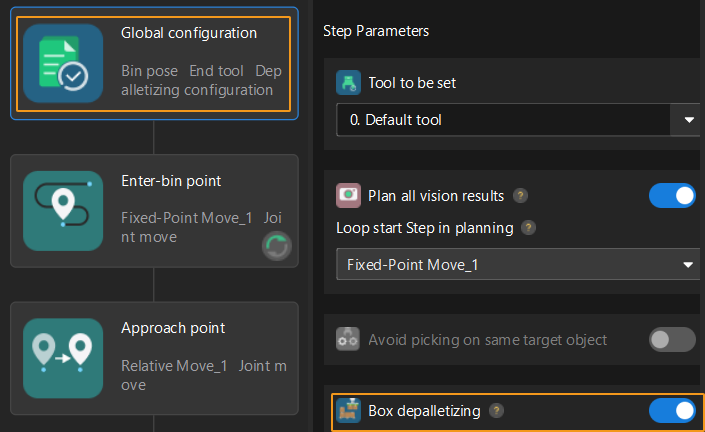
-
In the Path Planning Step, click Config wizard, and then double-click the name of the robot tool. In the pop-up window, select Depalletizing vacuum gripper for Tool type, click Configure depalletizing vacuum gripper, and then configure DO signals according to needs.
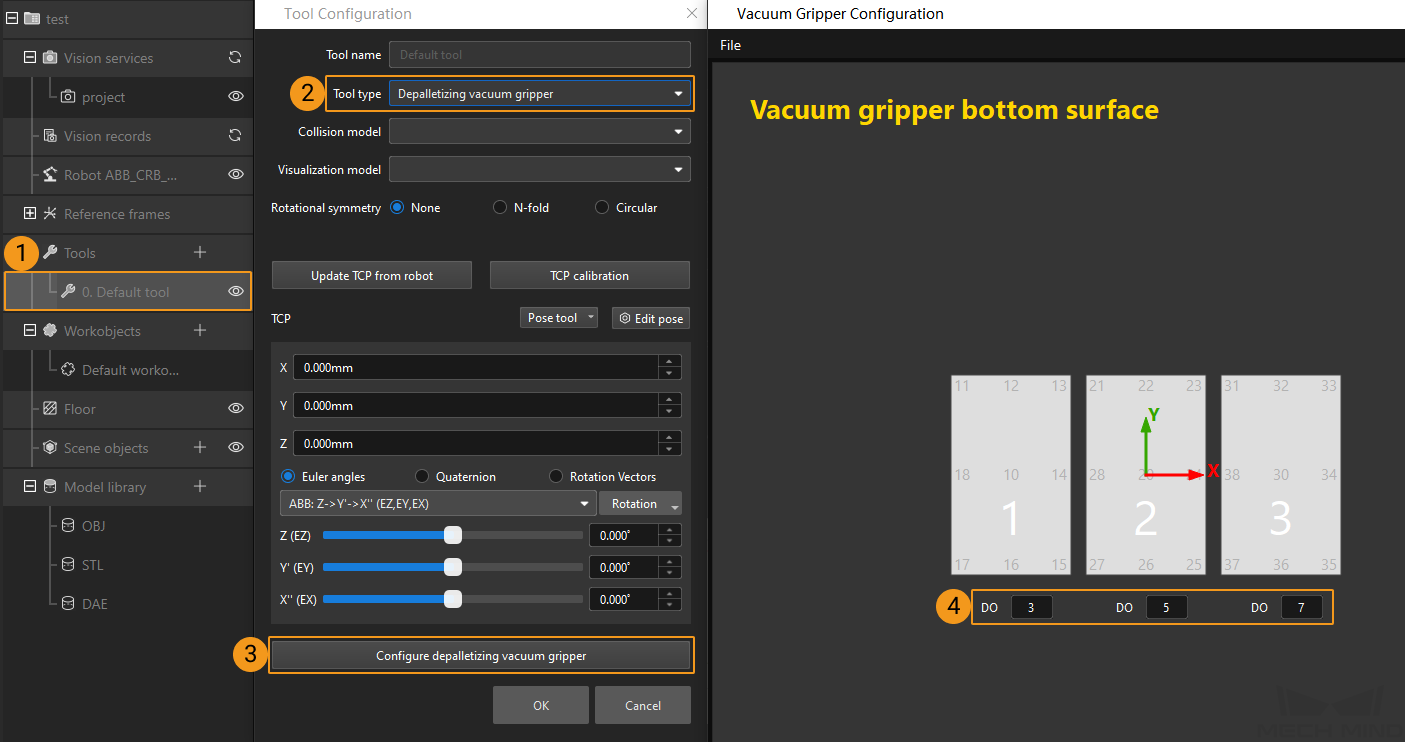
-
-
Configure the Mech-Viz project
-
In the Vision Move Step of Mech-Viz, set Select Picking Method to Box depalletizing.

-
In Mech-Viz, double-click the tool name, select Depalletizing vacuum gripper for Tool type, click Configure depalletizing vacuum gripper, and then configure the DO signals according to needs.
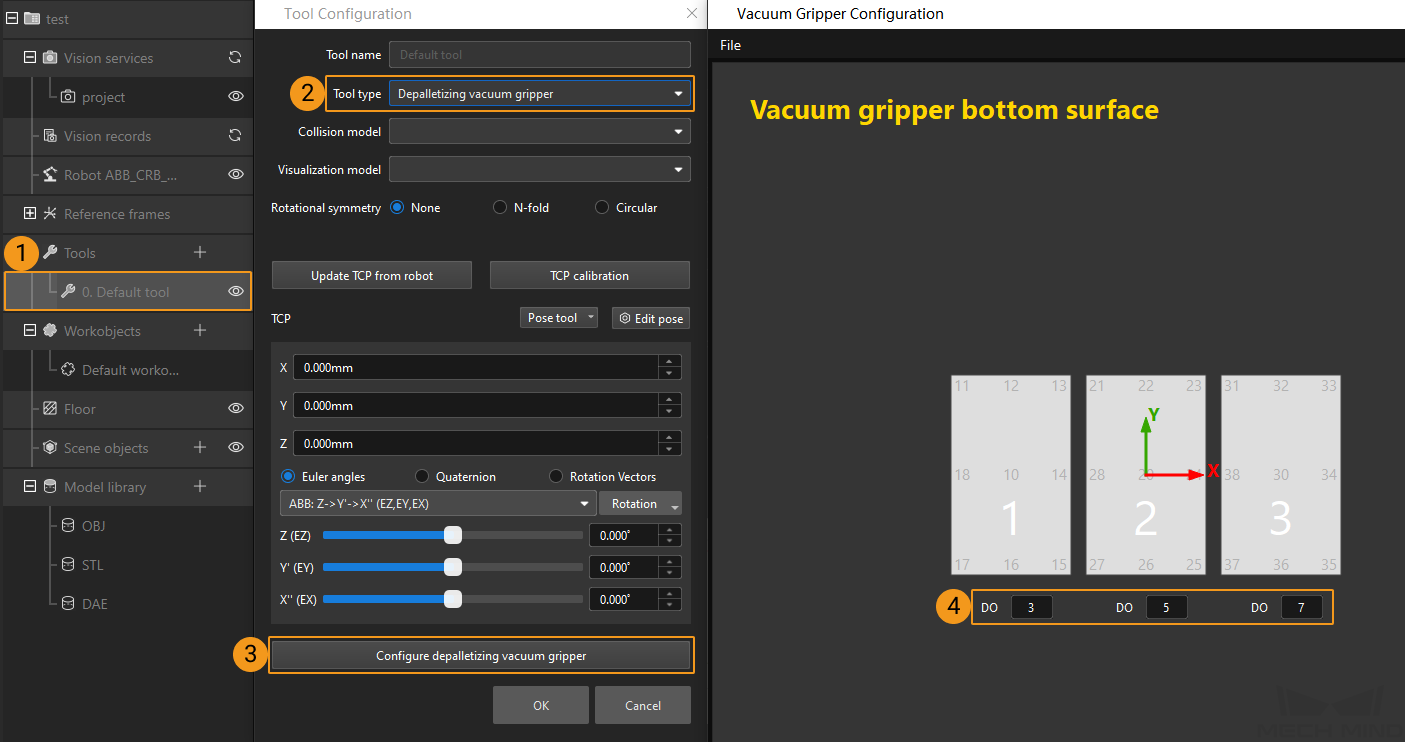
-
Calling Sequence
This command must be called before the Get Mech-Vision Dataor Get Mech-Viz Data command. This means that the robot must obtain the motion path and then obtain gripper DO signals of the Vision Move waypoint.
Command
MMGetDoListInput Parameters
Mech-Vision or Mech-Viz
This parameter specifies the source of the DO signal list. Valid values: Mech-Vision and Mech-Viz. The following table describes the details.
-
Mech-Vision: Get DO signal list from Mech-Vision. In this case, ProjectId will be displayed. ProjectId must be set to the Mech-Vision project ID.
-
Mech-Viz: Get DO signal list from Mech-Viz.
SuckerNum
This parameter specifies the number of gripper sections that are specified in the gripper configuration tool. For example, the number of gripper sections in the above image is 3.
Output Parameters
Do Data
This parameter indicates the number of obtained DO signals. The DO signals returned by this command vary based on the deployed project.
-
Gripper DO signals planned by the Mech-Vision project
-
Under Global Configuration of the path planning tool, if Plan all vision results is disabled, this command returns 64 gripper DO signals that are planned in this round. Valid DO signals are non-negative integers ranging from 0 to 999. Invalid DO signals are -1, which serves as a placeholder.
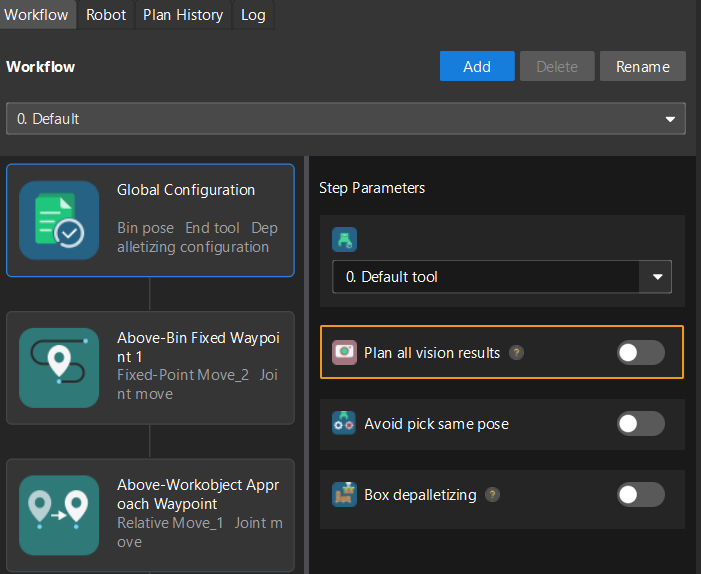
For example, valid DO signals in the table below are 1, 3, 5, and 6, which means that the robot will set the values of these DO signals to ON.
1st
2nd
3rd
4th
5th
6th
7th
8th
…
63rd
64th
1
3
5
6
-1
-1
-1
-1
…
-1
-1
-
Under Global Configuration of the path planning tool, if Plan all vision results is enabled, Mech-Vision can perform multiple rounds of planning based on the same vision result. The 64 gripper DO signals returned by this command are obtained during all rounds of planning. In this case, you can use the number of vacuum gripper sections to differentiate the gripper DO signals obtained during each round of planning.

For example, if the number of vacuum gripper sections is 4 and the command returns 64 DO signals in total, each 4 DO signals are multi-section vacuum gripper signals obtained during each round of planning.
First round of planning
Second round of planning
…
16th round of planning
1st
2nd
3rd
4th
5th
6th
7th
8th
…
61st
62nd
63rd
64th
1
3
4
-1
1
4
-1
-1
…
-1
-1
-1
-1
-
-
Gripper DO signals planned by the Mech-Viz project
-
If Reuse Vision Result is not selected for the Vision Move Step, this command returns 64 gripper DO signals that are planned during this round. Valid DO signals are non-negative integers ranging from 0 to 999. Invalid DO signals are -1, which serves as a placeholder.
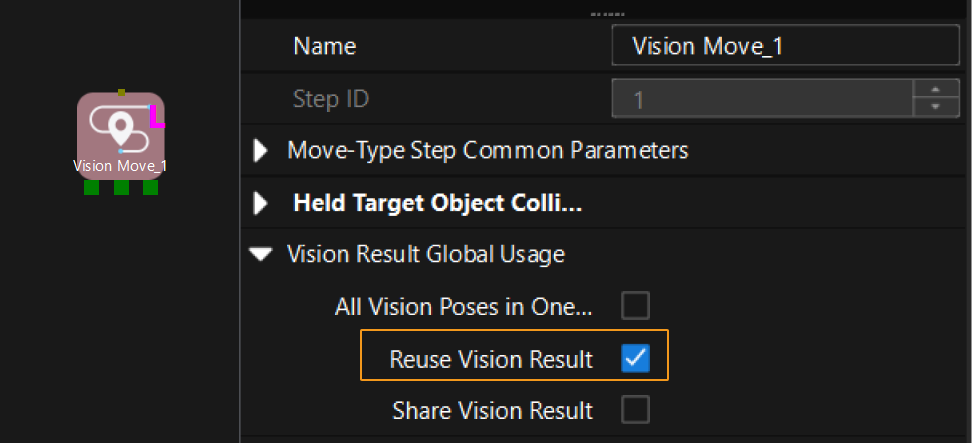
For example, valid DO signals in the table below are 1, 3, 5, and 6, which means that the robot will set the values of these DO signals to ON.
1st
2nd
3rd
4th
5th
6th
7th
8th
…
63rd
64th
1
3
5
6
-1
-1
-1
-1
…
-1
-1
-
If Reuse Vision Result is selected for the Vision Move Step and the Vision Move Step is used in a loop, Mech-Viz can perform multiple rounds of planning based on the same vision result. The 64 gripper DO signals returned by this command are obtained during all rounds of planning. In this case, you can use the number of vacuum gripper sections to differentiate the gripper DO signals obtained during each round of planning.
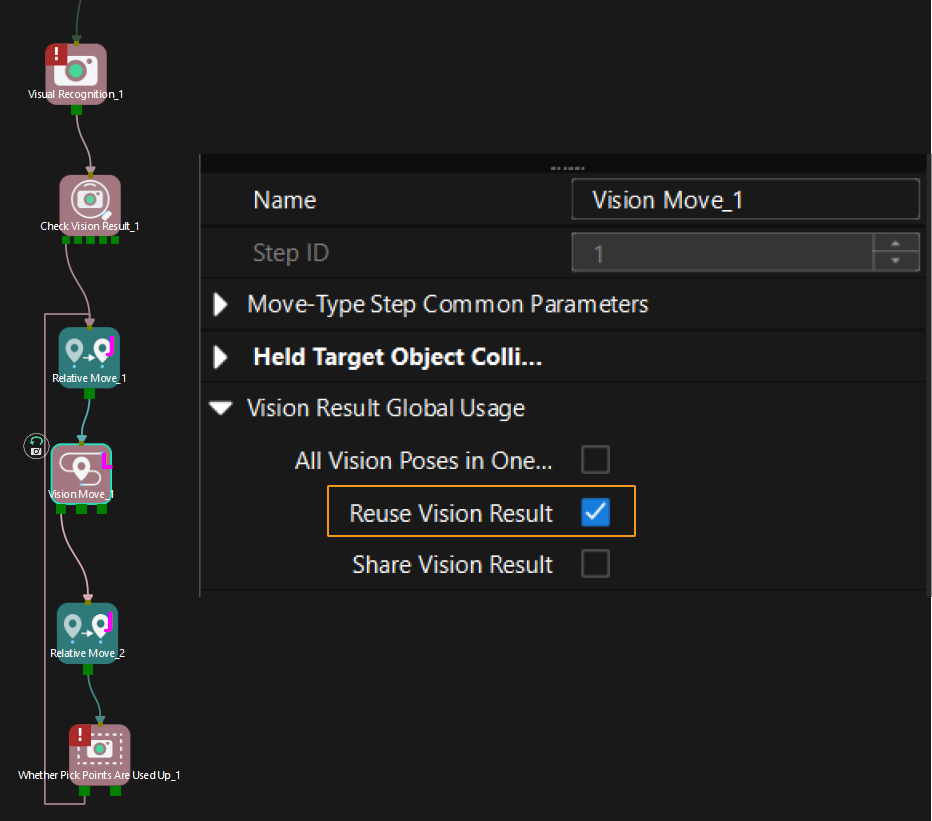
For example, if the number of vacuum gripper sections is 4 and the command returns 64 DO signals in total, each 4 DO signals are multi-section vacuum gripper signals obtained during each round of planning.
First round of planning
Second round of planning
…
16th round of planning
1st
2nd
3rd
4th
5th
6th
7th
8th
…
61st
62nd
63rd
64th
1
3
4
-1
1
4
-1
-1
…
-1
-1
-1
-1
-
Get Message from Notify Step
Description
When the Mech-Vision project or Mech-Viz project is executing the Notify Step, the vision system returns the message predefined in the Notify Step.
Before sending this command, complete the following settings for the Notify Step.
-
For a Notify Step in the Mech-Vision project:
-
Connect the Notify Step to the right side of another Step. The Output Step is used in the example in the image below.

-
Select Trigger Control Flow Given Output in the parameter panel of the Output Step.

-
In the parameter panel of the Notify Step, enter Standard Interface Notify (the value cannot be modified) for Service Name. Enter a positive integer for Message, for example, 1001.

-
-
For a Notify Step in the Mech-Viz project:
-
Connect the Notify Step to a proper Step in the workflow.
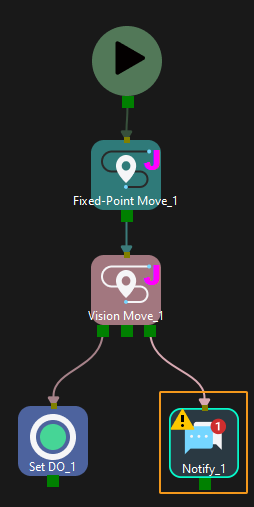
-
In the parameter panel of the Notify Step, select Standard Interface. Enter a positive integer for Message, for example, 1000.
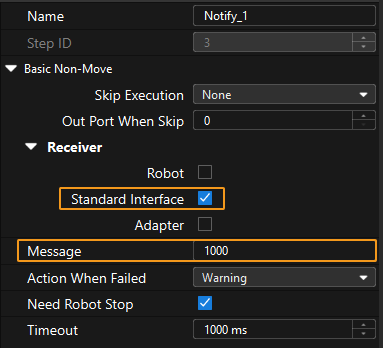
-
Calling Sequence
This command should be called after Run Mech-Vision Project or Run Mech-Viz Project.
Calibration
Description
This command is used for robot hand-eye calibration (extrinsic parameter calibration). This command must be used together with the Camera Calibration setting to complete automatic calibration. You can find Camera Calibration in the toolbar of Mech-Vision. For more information, see UR e-Series (PolyScope X 10.4 or Above) Automatic Calibration.
Command
MMCalibInput Parameters
PosJps
This parameter specifies the pose type of the calibration point. Valid values: Flange Pose and Joint Angle.
-
Flange Pose: TCP.
-
Joint Angle: Joint positions.
MoveType
This parameter specifies the motion type of the robot. Valid values: Movel and Movej.
-
Movel: Linear motion.
-
Movej: Joint motion.
| This command includes a built-in Move-to command, where Waypoint represents the position of the calibration start point. |
